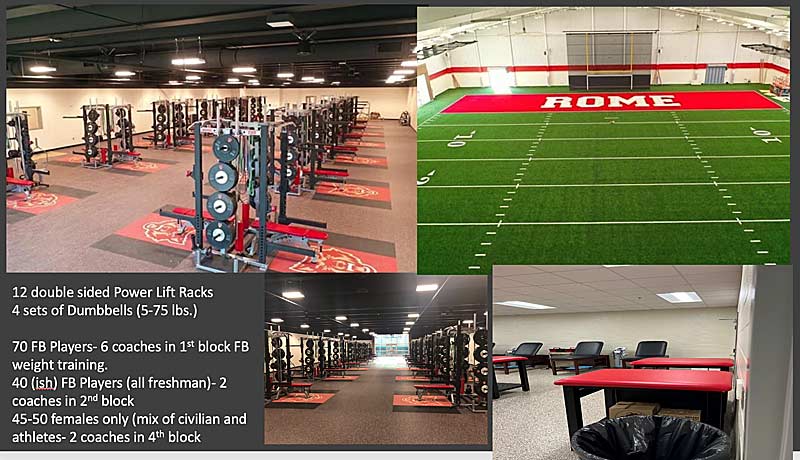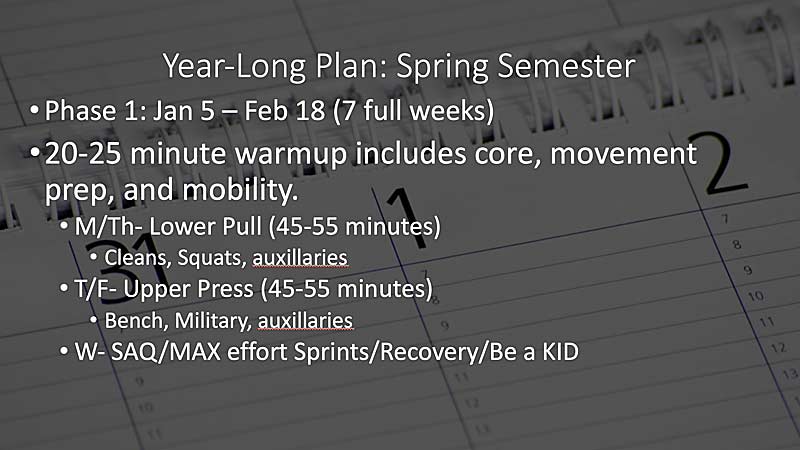
This week we switched things up to hear from a coach who has been coaching for a minute. Coach Muhammad Abdellatif has a plethora of high-level experience coaching football in the state of Georgia: his first head football coaching job forced him into the weight room and from there he never left. Now at football powerhouse Rome High School, he is quickly building buy-in from the sport coaches, showing player progress, and bringing energy to their program. This episode is about relationships, planning, and execution.
As performance coaches, relationships dictate everything. You can design the best program in the world, but if you fail to build the relationships that matter, athletes and coaches will not buy into it. Coach A details multiple layers of relationships, soft skills, and general tips that have helped build his program.
You can design the best program in the world, but if you fail to build the relationships that matter, athletes and coaches will not buy into it. Share on X
The truth of the matter is, in Georgia, the strength coach’s job is often heavily tied to the head football coach. While some coaches work with all sports, other coaches only service the football team and coach other athletes at certain times. The relationship that you build with the head football coach is paramount to earning autonomy and trust. A few ways Coach A highlights this are:
- Creating resources that aid the program without much cost.
- Being systematic.
- Being adaptable to change.
- Being an extension of the head coach.
Deliver athletes that support the head coaches’ vision for the team, not those that reflect your priorities. From there, buy-in leads to autonomy.
Relationships Set the Foundation
Relationships with the athletes go above and beyond the activities and conversations that support the weight room and their performance. Be the person, the influence, the athlete needs. Build in structure and love, promote kids’ successes (not just the stud athletes), let them be kids at appropriate times…and giving the opportunity to earn SWAG never hurts!

Finally, have a circle of coaches you can call any time—regardless of the topic or relevance to S&C—to build a network for the sake of relationships. This industry can hurl challenges at us that people outside of it don’t understand. Having that circle to help bounce ideas off, stay grounded, and realistically vent to goes a long way in our line of work.
Take time at the beginning of a session to explicitly state relational goals, explain the why behind the plan, or have fun in a way that instantly brings down walls between coaches and kids. Share on XHaving and communicating a plan to players and coaches goes a long way toward building buy-in and establishing orderly progressions within a coach’s system. In Episode 5, Coach A communicates his plan regarding his Olympic lifting teaching progression AND he explains the why behind the inclusion of the lifts in their program. His detailed explanation of the teaching progression from bodyweight to PVC to the barbell is an obvious foundation for his presentation’s extremely impressive clean videos. There is distinct evidence throughout this episode of his plan and obvious ways that he communicates it, from printed materials, homemade gym timers, descriptions of coaches’ communication, and more.
Planning & Execution
In the end, none of the other material matters without execution. Let me tell you, the videos that Coach shows in this presentation serve as powerful evidence of the execution of the program. Aside from the multiple 315lb cleans shown in this episode, the most important evidence of the execution of a highly successful program is the enthusiasm in the room. As performance coaches, we hold enormous power in the lives of 14-18-year-old athletes. Power to enhance skill and physical development, but more importantly, power to make kids fall in love with the weight room and with hard work, while establishing patterns that can last a lifetime.
Coach A shows multiple videos of kids in action in his room, but what stands out above the performance of the movements are the smiles on everyone’s faces. Celebrate successes, honor the hard work it takes to build what they’ve physically built. Athletes coming through his programs are building foundations and memories for a lifetime, while many are facing stresses of life that most adults cannot comprehend! Allow kids to celebrate, embrace life, and have fun!

Click here to view the recording of this week’s session.
Panel Q&A
This week’s panel was Missy Mitchell-McBeth, Aja Campbell, and Kyle Jacksic. Below are a few of their follow-up questions for Coach Abdellatif.
Coach Mitchell-McBeth: “Soft skills are an under-discussed communication component for coaches. When working with a difficult, hard-headed head coach, how do you manage compromise and draw the line when needed?”
Coach Abdellatif: “Starting in the pre-meeting with any coach, I explain my plan of what it looks like if we partner together to train their team. I will present how I would train their athletes and why I would train them in that manner. I outline my non-negotiable items, including rules, expectations, and boundaries. From there, they must understand that if we work together, this is how my program will be run. However, if they approach me and want to change a certain aspect of our training, I will ask them what they want to change and ask them why they want to change it. If we come to an agreement, I am open to compromise, but certain non-negotiables are communicated from the beginning to establish the things that I will not give on. If a coach doesn’t like it, they can schedule a time in the weight room to train their team themselves and not utilize me.”
I outline my non-negotiable items, including rules, expectations, and boundaries. From there, they must understand that if we work together, this is how my program will be run, says @CoachA33. Share on XCoach Campbell: “Who Olympic lifts in your weight room?”
Coach Abdellatif: “Everyone. Every team and non-athlete I have in class will learn to Olympic lift for the various benefits of the lifts (previously discussed in the episode). Now they may have a different progression based on where they are in the program, but the foundation of our program will be the Olympic lifts.”
Coach Jacksic: “How are you teaching and communicating your program and expectations to your co-teachers/other coaches in the room with you?”
Coach Abdellatif: “Every Sunday, I email our coaching staff a copy of the program. On Monday, a copy is waiting for them on their desk when they arrive. We discuss questions and suggestions pre-lift so everyone is on the same page. On the coaches’ card, I include coaching points that are very specific in the ‘how’ we want the movement executed. Luckily, our head coach supports the idea that if a coach isn’t willing to ‘coach’ hard in the weight room and would rather stand on the side of the room, drink coffee, and talk about last night’s Braves game, they will be removed from the weight room. The expectation is that you are coaching, coaching hard, and supporting our athletes.”
The expectation is that you are coaching, coaching hard, and supporting our athletes, says @CoachA33. Share on XNext week
To wrap up our final week of Summer School, on Tuesday July 18 at 8:00p.m. EST we will hear from Coach Jessica Gust of St Louis Park High School in Minnesota. Coach Gust is also on the advisory board for the Minnesota chapter of the NHSSCA and will bring some absolute heat to finish our series. The link to join the meeting is here—see you there!
Since you’re here…
…we have a small favor to ask. More people are reading SimpliFaster than ever, and each week we bring you compelling content from coaches, sport scientists, and physiotherapists who are devoted to building better athletes. Please take a moment to share the articles on social media, engage the authors with questions and comments below, and link to articles when appropriate if you have a blog or participate on forums of related topics. — SF

